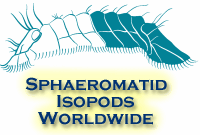| Abstract |
This paper presents a global review of the current unwieldy concept of the genus Paramunna Sars, 1866. The study is based mainly on large new collections of material from Australia and subantarctic islands south of Tasmania and New Zealand. Of the four genera previously synonymised with Paramunna, Austrimunna Richardson, 1906 is revived (type species A. antarctica), Leptaspidia Bate & Westwood, 1867 and Metamunna Tattersall, 1905 are considered indeterminable, while Austronanus Hodgson, 1910 is not considered part of the Paramunna complex. Forty-three species, 27 new, are treated, mostly from Australia and adjacent subantarctic islands. Fifteen species currently in Paramunna do not belong in this complex. The type genus Paramunna Sars, 1866 comprises four known species, P. bilobata Sars, 1866, P. capensis Vanhöffen, 1914, P. integra Nordenstam, 1933 and P. koreana Malyutina & Ushakova, 2001, and four new species. Nine new genera are created based on a cladistic analysis (type species, original combination): Ascionana (A. darwinia, sp. nov.), Epipedonana (E. profunda, sp. nov.), Harrietonana (Austrimunna subtriangulata Richardson, 1908), Kiklonana (Paramunna arnaudi Amar & Roman, 1974), Omonana (O. brachycephala, sp. nov.), Pagonana (Paramunna rostrata Hodgson, 1910), Palanana (Austrimunna serrata Richardson, 1908), Spiculonana (S. platysoma, sp. nov) and Sporonana (S. robusta, sp. nov.). Six species of Paramunna are transferred to other genera in the complex: P. simplex Menzies, 1962 and P. parasimplex Winkler, 1994 to Omonana, gen. nov.; P. dilatata Vanhöffen, 1914 to Pagonana, gen. nov.; P. gaini (Richardson, 1913) to Palanana gen. nov.; P. laevifrons Stebbing, 1910 and P. rhipis Shimomura & Mawatari, 1999 to Ascionana, gen. nov. Paramunna shornikovi Malyutina & Ushakova, 2001, is synonymised with P. rhipis. Keys to genera and species (if more than two in a genus) are given. Terminal males (males with elongated cephalon and massively enlarged pereonite 1) are documented in several genera. The distribution of the complex confirms that this part of the Paramunnidae is a Southern Hemisphere, shallow water group. Species previously thought to be circumpolar prove to be species complexes, with each species having a small distribution. |

















